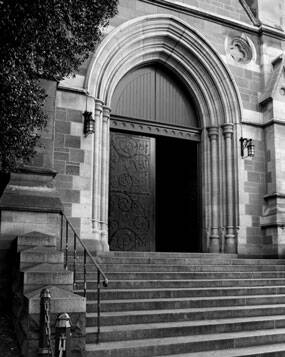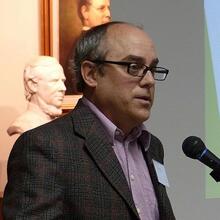During Pope Benedict XVI’s historic visit to the United States this year, many commentators remarked that the supreme shepherd of the church was tending a rapidly shrinking American flock. They based their conclusion on the U.S. Religious Landscape Survey, published in February 2008 by the Pew Forum on Religion and Public Life, which reported that “Catholicism has experienced the greatest net losses” of any religion in the United States and that “roughly 10 percent of all Americans are former Catholics.”
Reporters in both secular and Catholic media were quick to use terms like “bleeding” and “hemorrhaging” to describe changes in the Catholic population. Luis Lugo, director of the Pew Forum, said “the Catholic numbers are eye-popping.” Commentators were swift to assign blame and identified “obvious” reasons for these changes, such as the recent sexual abuse crisis, the continuing shortage of priests and the long-term effects of the Second Vatican Council. Yet on closer inspection, Catholic Church leaders have less to worry about than it may seem. The Pew numbers do not reflect any new crisis.
The Catholic Church may be the “biggest loser” in terms of total population loss, but it is important to remember that the Catholic Church is also the single largest Christian denomination in the United States. Proportions matter. As bad as the losses have been, they would be even worse if Catholics were losing their young faithful at the same rate as every other U.S. Christian denomination. None of these other Christian churches has had as much success as the Catholic Church in retaining as adults members who were raised in the faith. The Pew study reports that the Catholic Church has retained 68 percent of those who grew up Catholic. By comparison, 60 percent of those raised Baptist are still Baptists as adults; the number is nearly the same for Lutherans (59 percent). The retention rates are lower for Methodists and Pentecostals (both 47 percent), Episcopalians (45 percent) and Presbyterians (40 percent). Of all the faith groups in the United States, only those who were raised as Hindu, Jew, Orthodox or Mormon are more likely than Catholics to keep their faith as adults (84, 76, 73 and 70 percent retention rates, respectively). Actually, the Pew numbers demonstrate that the Catholic Church is among the most successful at retaining those raised in their faith.
It is the case that more “Protestants stay Protestant” (80 percent), but this statistic masks the large volume of switching that occurs among Protestant denominations. The relative ease with which such a move can be made does not mean that it is somehow less relevant. Each denomination has its own unique customs, rituals, traditions, teachings and style; and switching from one to another brings change for the individual and the members of the churches involved. Although the expression about Protestants staying Protestant may have sociological and historical validity, the concept lacks relevance in the real world for the persons who make these changes and the religious organizations that lose and receive these members. Researchers may choose not to recognize a respondent’s change of faith group as a “real change,” but this does not mean the individuals making these changes (or the churches losing or gaining their membership) share such an interpretation.
When the Losses Occurred
Even with better retention rates than most, the Catholic Church is still losing too many members. Yet it is also important to understand that these losses have not occurred in any recent exodus. The results reported by Pew do not include information about when a respondent left his or her faith. But other social scientists have studied this particular question. In a 2003 national random-sample telephone poll, for example, the Center for Applied Research in the Apostolate at Georgetown University asked American adults who said they were raised Catholic, but who no longer self-identify as such, the following question: “About how many years ago did you stop thinking of yourself as Catholic?” Respondents had a tendency to answer this open-ended question with round numbers, like one, five, 10, 15 or 20 years ago, rather than by specifying a year. A majority of these former Catholics said they stopped considering themselves Catholic before 1988 (54 percent). The percentage who in 2002 responded “last year” is statistically not different from that of respondents who said they left “five years ago,” “10 years ago” or more. In fact, former Catholics were more likely to name “30 years ago,” that is, 1972, than any other interval (10.8 percent of all those who have stopped considering themselves to be Catholic). These results reflect the incremental life-cycle changes that affect people’s faith life, such as the coming-of-age process, which may lead one to question childhood beliefs, or marrying someone of another faith, which may affect practice. Also, social scientists have long understood that some of those who no longer identify with the faith in which they were raised, especially those who currently say they are “unaffiliated,” will return to that faith later in life.
An Error of Size
Church leaders and Catholics in general should also be aware that the Pew results underestimate the size and composition of the Catholic population. Although Pew conducted more than 35,000 interviews, which resulted in a margin of sampling error of 0.6 percentage points, there is no safety in these numbers because sampling error is just one type of potential error. Pew researchers note in the report that an unusually low number of Latino respondents identify themselves as Catholics. In a three-page explanation of this phenomenon, the researchers explore other potential sources of error that could have caused this result, including question wording, unrepresentative sampling and problems caused by the language options for the survey. Pew conducted a follow-up survey, which confirmed that the U.S. Religious Landscape Survey had indeed underestimated Latino Catholic affiliation. The Pew researchers conclude thus:
This means the Landscape Survey underestimates the proportion of Latinos who are Catholic. By extension, it may also slightly underestimate the proportion of the U.S. Catholic population that is Latino and marginally underestimate the proportion of the U.S. population that is Catholic.
Instead of identifying themselves as Catholic, a sizable number of Latinos in the survey identified themselves as “unaffiliated.” Although the Pew researchers seek to reassure readers that because of the “missing” Latino Catholics, the report may only “marginally underestimate the proportion of the U.S. population that is Catholic,” this error has an impact on the interpretation of the Catholic data. The difference between the 58 percent identification among Latinos in the Pew survey and the more typical 68 percent affiliation found in other studies, including some conducted by Pew, is equivalent to 2.7 million U.S. adults (or 1.2 percent of the total U.S. population). To put the size of this error in Pew’s comparative terms, the 2.7 million adult Latino Catholics “missed” in the Religious Landscape Survey are equivalent to or larger than all but 10 of the other specific religious faith groups identified by Pew researchers in the U.S. population. If the Pew survey had not been affected by this methodological problem, the Catholic retention rate would have been more than 70 percent, which is consistent with previous CARA estimates.
The Catholic Church should be concerned about losing members. But the results of the Pew study do not reflect a recent mass exodus from the Catholic faith. The changes it reflects have occurred incrementally over a long period, most often among young adults and teens; the changes are most often related to marriage, leaving home and migration to new environments. The average age at which former Catholics said they stopped considering themselves to be Catholic in CARA’s 2003 poll was 21, and only 14 percent of former Catholics said they were older than 35 when they left the church. The average age at the time of leaving has risen slightly over the decades from the early 20s (up until the 1990s) and now into the mid-20s. This change corresponds to the longer periods Catholics and non-Catholics alike are waiting to leave home and marry. Thus, the church’s concern for and focus on young adults should be nothing new. This is the population church leaders should continue to focus on now to stem future losses.








